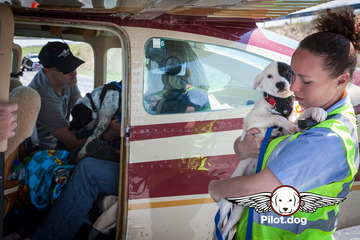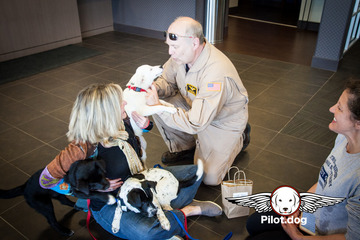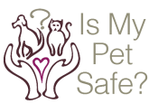Animal Rescue Air Transport
All photos in this post are provided by and copyright of Pilot.dog, images are resized for publication purposes.
Natural and other types of disasters often result in pets being separated from their families. Unfortunately, this can often result in pets ending up lost or abandoned with rescue operations their only hope for survival. As we near National Animal Disaster Preparedness Day, I thought this would be a good time to take a closer look at one organization that helps facilitate uniting rescue dogs with a new home and family.

For most people animal rescue brings to mind their local animal shelter. What they may not know is that many rescue pets travel long distances to get to their new adoptive pet parents. For these animals, air rescue flights are indispensable in making the long journey possible.
There are many charitable organizations providing air transport across the United States. Though a core group of pilots may associate themselves with a particular group, many pilots will periodically check on-line bulletin boards or smart phone apps for pets in need of transport. Most of these pilots are recreational, weekend flyers using small planes with limited range (200-300 miles) and are only certified for flying under visual flight rules (VFR). This means long distance rescue flights can involve many pilots and ground based drivers and coordinators.
This is tricky work even under the best of circumstances and can be further complicated by the need for state specific paperwork. Many states consider the delivery of "non-owned" pets as importation and thus have regulations that must be met for a hand-off to be successful.
This past week I spoke to Steve Rhode, founder of Pilot.dog, located in Raleigh, North Carolina. Though there are more established groups out there such as Animal Rescue Flights or others like Wings of Rescue that ferry more animals at a time, I felt Steve's group deserved recognition for the hard and good work they do.
Pilot.dog is one of the many organizations and single pilots who operate out of the small and regional airports across the United States. Regrettably, it is impossible to get accurate statistics on how many animals facing euthanization have been saved by volunteer air transports but the figure is easily in the 10's of thousands each year.
Steve started flying dogs way back in 1988 but his VFR only rating limited how far he could fly and gave him pause over managing long flights that would involved multiple pilots. All that changed in early 2015 when Steve passed his instrument flying rating.
IMPS: When and why did you form Pilot.dog?
PD: We started the IRS approved non-profit group Pilot.dog soon after we started sharing stories about our flights. It became clear very quick that people were interested in what we were doing and we needed something to call ourselves other than, "you know that couple, Steve & Pam in North Carolina who fly dogs." Having an identity helped to rally volunteers and and allowed us a chance to connect with people to form a great community.
IMPS: What is the typical distance you fly?
PD: We tend to do longer flights than infrequent pilots do. By flying longer legs, say 250-300 miles each way, we don't have to make as many connections with others, which cuts down on the uncertainty if the pilot on the other end is going to be able to make it in. That has happened. Luckily our plane cruises at about 180 MPH.
But it also means that these can very quickly turn into very long days with flying, stops, and lunch breaks. I flew seven hours yesterday.
Steve goes on to say that about half of Pilot.dog's flights are direct flights for the passenger, the remainder adding one more connecting flight. So not that different than what two legged flyers are used to. He also indicates that much of the traffic he sees is south to north.
However, Pilot.dog is also involved in wider area transport efforts and feels that a website called Doobert (doobert.com) has helped facilitate getting pilots, ground transporters and others together in the same place.
Important to remember is that Pilot.dog is (for now) a single pilot organization with support from many volunteers on the ground. Pilot.dog is also a transport only organization, preferring to leave the major coordination effort to other volunteer organizations.
In a few days we are going to be part of a 1,200 mile transfer. It will involve both ground transporters and three pilots. The combination approach is perfect for dealing with big trips or that first and last 50 miles. It's also great if a pilot can't be found for some out of the way leg. If anyone is interested in being a ground transporter they should register on Doobert.com.
Doobert covers a lot of animal rescue functions - helping to find foster and permanent homes for rescues, providing a way for interested ground and air volunteers to meet, plan and map out a transport and even fund raising. Doobert also has smart phone applications for those less attached to their desktops or who spend a lot of time in the field. If you are interested in volunteering your time, car or plane, please check doobert.com

IMPS: From time to time Pilot.dog flies dogs with medical issues. I asked Steve about the challenges of medical flights:
PD: We have flown dogs that have faced medical issues, required advanced medical testing, or needed surgery. The key thing to remember is the dogs are not feeling well, stressed, tired, nervous, and can be scared. The best tool to use on those flights is compassion, kindness, and sympathy. In my mind you can never provide too much TLC for a dog in trouble.
I was also curious about the types of problems that pop up in animal air transport having seen so many difficult air transports of two legged children. Perhaps surprisingly, air sickness is not a big issue, in part because of preflight planning. Pilot.dog advises all rescues to stop feeding the dog the night before an expected flight and only provide water in the morning. If the dog does show indications of stomach upset, Steve and his assistants find a bit of a ginger snap quiets things down.
However, the most frequent problem is one that is probably easiest solved and should be remembered by pet parents who may sometimes care for unfamiliar dogs:
But I would say the most common problem I see with other transporters is not putting a harness on the dogs. The dogs can often easily back out of the single neck collar and many have escaped from pilots that way at airport transfers. The first thing we do is put our own harnesses on the dogs while they are in a confined space and transfer the leash to the harness. We also use the harness to secure the dog in the plane so they can move but are secured.
The diverse group of pilots who volunteer their time and planes to fly animals in need breaks down into two camps. Those with bigger planes or who operate out of an area with more pilots available often do mass transports - they are the UPS of animal air transportation. Others have smaller planes, fewer pilots available or just prefer to handle a small number of pets at a time. Pilot.dog falls into the latter group.
IMPS: Pilot.dog only flies a single or small number of dogs at a time. Is this intentional or just a function of logistics?
PD: Excellent question. It's one I've had a lot of conversations about. I know some great pilots who will pack the dogs into a plane and move as many as possible at one time. It makes great economic sense when you consider the number of dogs flown versus the cost of the flight. There are good arguments to be made for this approach.
But Pam and I both feel we can deliver a different level of transport care by limiting the number of dogs on a flight. Only the rescues we transfer dogs for can make the determination about which approach they prefer. I'm not out to persuade anyone what the right approach is because I think they both have pros and cons.
Steve and Pam believe there are a number of reasons why the 'smaller is better' approach has advantages. To start, flying can be a stressful situation for a rescue dog that has already been through a lot. Putting multiple dogs who do not know each other together adds to that stress and may lead to conflict. For that reason Pilot.dog will not fly multiple dogs if they are unfamiliar with each other.
Second, the personal touch goes a long way to assuring the dog does not have a traumatic experience in being transferred to a new pet parent. Blankets, cuddles and petting help reduce the stress of the flight, all provided by Pilot.dog flight volunteers. Steve also feels this is a great introduction to rescue dogs for his volunteers.
Unfortunately, Pilot.dog is a canine only operation. That is not 100% by choice; Steve is highly allergic to cats! Though once asked to fly a pig, the organization turned down the request, preferring to stick to what they known best - canine transport.
IMPS: What are the most important things a person/group requesting a flight needs to do or know?
PD: Hands down, the most important thing is good communication and the ability to get the back story on the dog and send us pictures of the dogs. And rescues need to plan ahead. Almost nothing good comes a frantic call with a desire to fly a dog tomorrow. As part of my flight training I was taught a concept, "Slow is Fast." Meaning it is better to develop a mission in an orderly way rather than rush and miss something critical. It's better to do it all right the first time than frantically have to try to fix a mess later.
We take flying dogs seriously. We are very focused on making sure everything is in order and thought about ahead of time. This way the mission has the best chance of success, there is a shared plan of action, and we communicate with everyone before, during, and after we are on the way. And while I might be the pilot, Pam's role dealing with logistics and planning is equally as important.
Pilot.dog also trains their flight volunteers to account for the many emergency situations they may encounter, both mechanical and canine. Muzzles are kept handy in case a dog becomes aggressive and numerous check lists are reviewed prior to flight, in-flight and before landing.
IMPS: What can pet parents/friends do to help or be involved?
PD: Monetary donations are always welcome but we are very open in engaging people into our community and allowing them to share the experience. We have a program to allow people to volunteer to fly with us. Those that are more interested are on a short list of repeat flyers who know the process and take responsibility for the dogs in flight.
I think people can also do easy and free things to participate. These would include making sure to subscribe to our website email list and get the latest information and flight stories. People can also really help by sharing our information and flight stories on social media or with friends.
Recently we did our first hangar open house and had a number of people come by the airport, crawl into the plane, and ask lots of questions. That was a really fun experience. We are located at the Raleigh-Durham International Airport and love to share what we do with others.
Air transport is not cheap and Pilot.dog's costs run about $140/hr for fuel and ongoing maintenance. For a five hour round trip that comes to $700. Please consider making a donation. Pilot.dog is a IRS 501(c)(3) charity.



